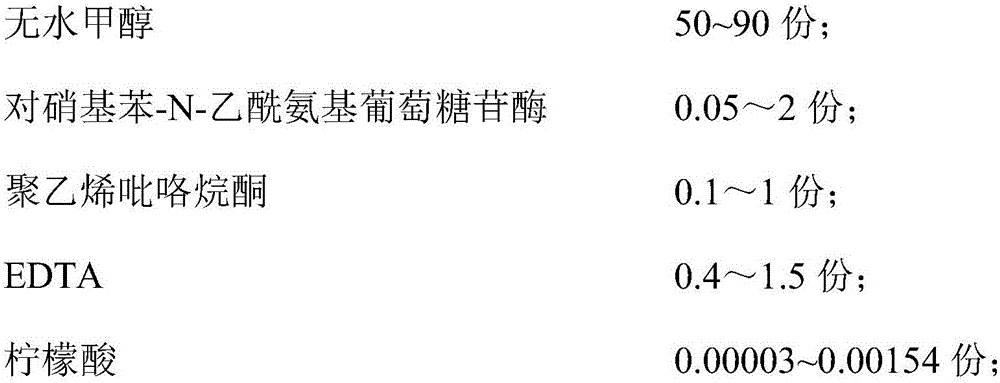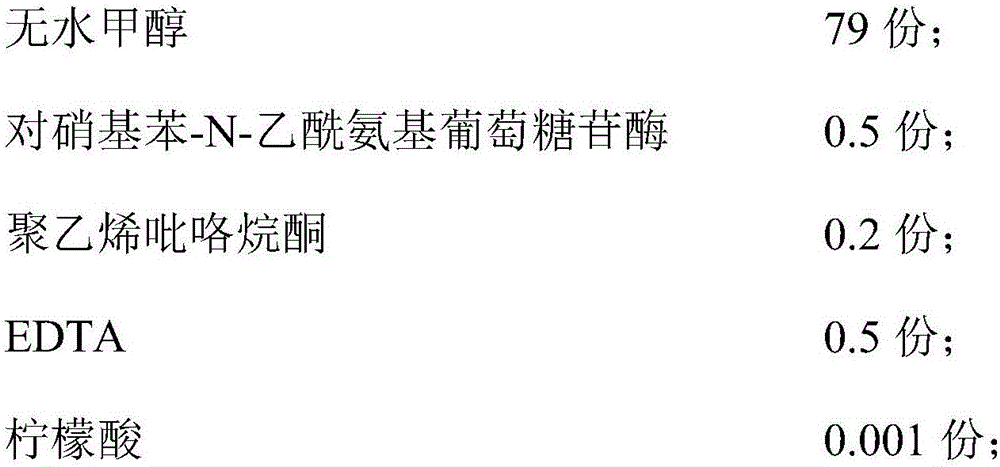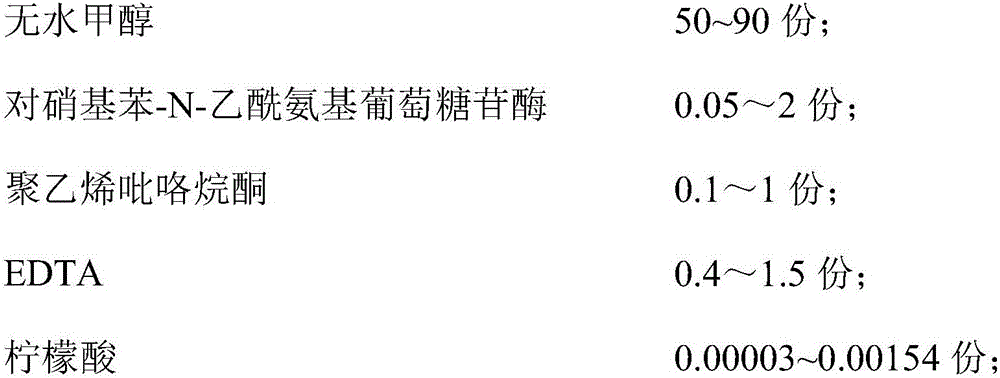Acetylglucosaminidasedetection reagent, reaction pad, preparation method of reaction pad and kit
A technology of glucosidase and acetylamino, which is applied in the field of acetylglucosaminidase detection reagents, can solve problems such as lack of accuracy, and achieve the effects of good accuracy, high efficiency, and simple and convenient use conditions
- Summary
- Abstract
- Description
- Claims
- Application Information
AI Technical Summary
Problems solved by technology
Method used
Image
Examples
preparation example Construction
[0047] The preparation method of this reaction pad comprises the following steps:
[0048] 1) Material preparation: prepare anhydrous methanol, p-nitrobenzene-N-acetylglucosaminidase, polyvinylpyrrolidone, Triton X-100, EDTA and citric acid according to the above parts by weight;
[0049] 2) Prepare soaking solution A: fully dissolve p-nitrobenzene-N-acetylglucosaminidase in anhydrous methanol to obtain soaking solution A;
[0050] 3) Prepare soaking solution B: dissolve polyvinylpyrrolidone, Triton X-10, EDTA and citric acid in pure water to obtain soaking solution B;
[0051] 4) Soaking solution A treatment: put the filter paper in the soaking solution A and fully soak it for 10-20 seconds, then take it out, and then dry it at a temperature of 20-70°C for 30-40 minutes to obtain a filter paper of the soaking solution A;
[0052] 5) Soaking solution B treatment: soak the filter paper of soaking solution A in soaking solution B for 10-20 seconds, take it out, and then dry it ...
Embodiment 1~3
[0059]Embodiments 1-3 disclose a kind of acetylglucosaminidase detection reagent, respectively prepare three groups of raw material components according to Table 1, and prepare sodium hydroxide solutions with different concentrations according to Table 2 as chromogen; Group A is used in Example 1 , Group B is used in Example 2, and Group C is used in Example 3.
[0060] Dissolve anhydrous methanol, p-nitrophenyl-N-acetylglucosaminidase, polyvinylpyrrolidone, Triton X-10, EDTA and citric acid in 100mL of pure water in sequence to obtain a reactant; , to obtain coagulase detection reagent.
[0061] The composition and content of table 1 reactant
[0062]
[0063] The preparation parameter of table 2 chromogen
[0064]
[0065] Detect the detection reagents obtained in Examples 1 to 3: prepare acetylglucosaminidase standard solution with different enzyme activity concentrations respectively, and the acetylglucosaminidase standard solution uses physiological saline as a so...
Embodiment 4~6
[0072] Embodiment 4~6 discloses a kind of kit:
[0073] 1) Prepare materials according to Table 1 and Table 2; Group A is used in Example 4, Group B is used in Example 5, and Group C is used in Example 6;
[0074] 2) Prepare soaking solution A: fully dissolve p-nitrobenzene-N-acetylglucosaminidase in anhydrous methanol to obtain soaking solution A;
[0075] 3) Prepare soaking solution B: dissolve polyvinylpyrrolidone, Triton X-10, EDTA and citric acid in pure water to obtain soaking solution B;
[0076] 4) Soaking solution A treatment: put the filter paper in the soaking solution A and fully soak it for 10-20 seconds, then take it out, and then dry it at a temperature of 40°C for 40 minutes to obtain a filter paper of the soaking solution A;
[0077] 5) Treatment of soaking solution B: put the filter paper of soaking solution A into soaking solution B for 10-20 seconds, take it out, and then dry it at a temperature of 45°C for 30 minutes to obtain a reaction pad;
[0078] 6)...
PUM
 Login to View More
Login to View More Abstract
Description
Claims
Application Information
 Login to View More
Login to View More - R&D
- Intellectual Property
- Life Sciences
- Materials
- Tech Scout
- Unparalleled Data Quality
- Higher Quality Content
- 60% Fewer Hallucinations
Browse by: Latest US Patents, China's latest patents, Technical Efficacy Thesaurus, Application Domain, Technology Topic, Popular Technical Reports.
© 2025 PatSnap. All rights reserved.Legal|Privacy policy|Modern Slavery Act Transparency Statement|Sitemap|About US| Contact US: help@patsnap.com



